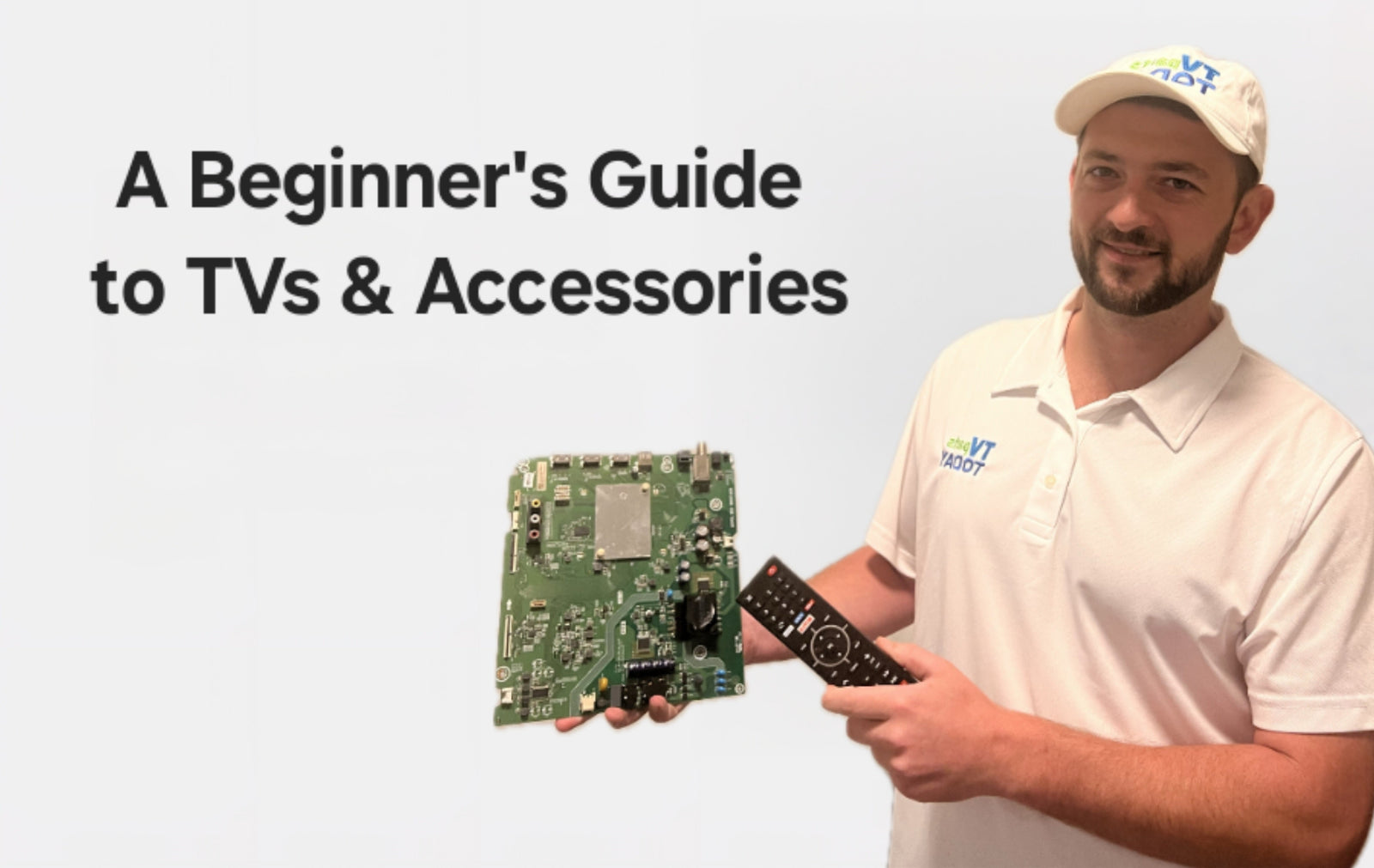Understanding TV Screen Sizes and Compatibility
Choosing the Right Size for Your Space
Selecting the ideal TV size is essential for the best viewing experience! Follow these simple guidelines to find the perfect fit for your room:
- Consider the Viewing Distance: The optimal distance between your TV and seating area should be about 1.5 to 2.5 times the diagonal size of your screen. 📏
- Room Size and Layout: Smaller rooms are best suited for TVs ranging from 13" to 40", while larger spaces can accommodate 42" to 65" screens or even 85" to 100" for an immersive experience.
- Resolution and Screen Size: As the screen size increases, so does the need for higher resolution. A 4K or 8K TV ensures sharp picture quality, even at larger sizes.
Remember, the right TV size also depends on personal preference and the primary use - whether it's for gaming, movies, or regular viewing. Make sure it fits your space and usage needs.
TVpartsToday Tip:
For a more immersive experience, larger TVs like 75" and up are perfect for home theaters or spacious living rooms. Consider a 4K or 8K model for optimal clarity at these sizes.
Need help with a repair, instead? Check out our helpful YouTube video on getting started:
Compatibility with TV Stands and Wall Mounts
When selecting a TV, consider how it will fit into your space. It's important to choose a stand or wall mount that complements your TV’s size and weight.
- Size Matters: Ensure the stand or mount is designed for your TV’s size. Common categories include: 13" - 40", 42" - 65", and 70" - 100".
- Type of Mount: Choose between fixed, full-motion, or tilting wall mounts based on your viewing needs. Full-motion mounts offer flexibility, while fixed mounts provide a sleek look.
- Weight Capacity: Double-check that your stand or mount can safely hold your TV’s weight, especially for larger models.
- VESA Compatibility: The VESA standard refers to the distance between the mounting holes on the back of your TV. Ensure the mount matches your TV’s VESA pattern.
- Additional Features: Some models, like the LG G3, include built-in wall mounts for a streamlined installation. However, optional stands can sometimes come at a premium price.
TVpartsToday Tip:
If you're wall-mounting a large TV, make sure to choose a mount that supports your TV’s weight. Consider tilting or full-motion mounts for flexible viewing angles.
Product Ranges for Different Screen Sizes
TVs come in a variety of sizes to fit your space. Here’s a breakdown of the ranges available:
- 85" - 100": Ideal for home theaters and large living rooms, providing an immersive experience.
- 75" - 83": A balance between grandeur and practicality. Perfect for spacious living rooms.
- 65" - 70": A popular choice for average-sized rooms, perfect for everyday use.
- 55" - 60": Versatile for various settings, such as bedrooms and smaller living spaces.
- 48" - 50": Compact for tighter spaces without sacrificing screen size.
- 40" - 44": Great for personal use or smaller rooms where space is limited.
- 22" - 32": Ideal for kitchens, dorm rooms, or as secondary screens.
TVpartsToday Tip:
Before purchasing, always measure your space and compare it with the TV's dimensions, including the bezel, to ensure a good fit.
Navigating Through TV Cables and Accessories
Essential Cables for Your TV Setup
A proper TV setup depends on using the right cables. Here’s a simple guide to ensure everything runs smoothly:
- HDMI Cables: The go-to for modern TV connectivity, transmitting high-definition video and audio from your devices.
- AV Cables: Necessary for older equipment like DVD players and VCRs.
- Power Cables: Ensure your TV and devices are connected to a reliable power source.
TVpartsToday Tip:
Invest in high-quality HDMI cables to avoid signal loss and ensure a stable connection for 4K or 8K content.
Enhancing Your Experience with Accessories
Elevate your viewing setup with these essential accessories:
- Sound Systems: Enhance audio with a quality soundbar or surround sound system.
- Universal Remotes: Simplify control with a programmable remote for all your devices.
- Streaming Devices: Expand your options with smart devices that offer streaming and other entertainment options.
- Cable Management: Keep your area organized and free from clutter with cable organizers.
TVpartsToday Tip:
For ultimate comfort, invest in ambient lighting or smart lighting systems that pair with your TV for a cinema-like experience.
Surge Protection and Power Accessories
Protect your TV from power surges with these helpful tips:
- Surge Protector with High Joule Rating: Choose a surge protector with a high joule rating to absorb power spikes.
- Sufficient Outlets: Ensure the surge protector has enough outlets for your TV, sound system, and other devices.
- EMI/RFI Noise Filtering: Select a surge protector with noise filtering to improve your TV's audio and video quality.
TVpartsToday Tip:
Always use a surge protector with your TV to avoid costly repairs caused by unexpected power spikes. Don't forget to check for extended warranties on the protector.
Selecting the Best TV Features for Your Needs
Comparing 4K, 8K, OLED, and QLED TVs
In the world of high-definition TVs, it’s crucial to understand the differences between 4K, 8K, OLED, and QLED technologies:
- 4K and 8K: Higher resolution means sharper, more detailed images. 8K offers more pixels than 4K, but may not be essential unless you're watching ultra-high-definition content.
- OLED: Known for perfect blacks and exceptional contrast. Each pixel emits its own light for outstanding picture quality.
- QLED: Offers vibrant colors with quantum dot technology enhancing LED-LCD panels. Brightness and color vibrancy are its strengths.
TVpartsToday Tip:
For the best contrast and vibrant colors, go for an OLED TV. For brighter displays, especially in well-lit rooms, a QLED TV may be a better choice.
Smart TVs and Connectivity Options
Modern Smart TVs are packed with features for a connected lifestyle. Consider the following connectivity options:
- Wi-Fi: Essential for streaming services. Ensure your TV supports the latest Wi-Fi standards.
- Ethernet: A wired connection offers a more reliable and stable internet experience, especially for 4K streaming.
- Bluetooth: For wireless headphones, soundbars, or controllers.
- HDMI/USB Ports: Make sure there are enough ports for all your devices, such as gaming consoles and Blu-ray players.
TVpartsToday Tip:
Check for voice assistant compatibility (Alexa, Google Assistant) to control your TV hands-free, enhancing the smart home experience.
Latest TV Models and Future Releases
Stay ahead of the curve by keeping up with the latest models and innovations:
- Samsung: The S95C OLED and QN900C 8K models are leading the charge in 2024.
- LG: The G3 model is ideal for wall-mounting with superior picture quality.
- Sony: Renowned for motion handling and color accuracy - perfect for sports and fast action.
TVpartsToday Tip:
When upgrading your TV, consider future-proofing by investing in 8K models or QD-OLED technology for top-tier color accuracy and contrast.
Need Help?
If you’re still unsure about the issue or need to replace a part, reach out to TVpartsToday. We can help you identify the exact cause of the problem and provide the right replacement part!
Would you rather watch a video? Check out our helpful Troubleshooting 101 playlist over on YouTube!
Would you rather chat with a seasoned repair expert? Head on over to our TVRepairHelp subReddit!
Need help finding the right board or part?
Call us at 930-212-1975 or browse our inventory online.
DIY-friendly parts, fast shipping, and expert support – only at TVpartsToday.

